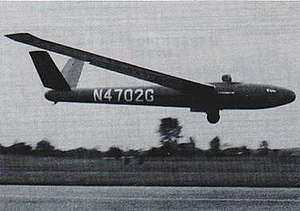Kohler Alpha
The Kohler Alpha is an American, mid-wing, V-tailed, FAI Open Class single seat glider that was designed and built by Spud Kohler of Cleveland, Ohio.[1][2][3]
| Alpha | |
|---|---|
 | |
| Kohler Alpha | |
| Role | Glider |
| National origin | United States |
| Designer | Spud Kohler |
| First flight | 1965 |
| Introduction | 1965 |
| Number built | One |
| Developed from | Schreder Airmate HP-11 |
Design and development
Kohler built the Alpha in 1965 as a development of the Schreder Airmate HP-11. He used the wings from the HP-11 and combined this with a newly designed fuselage and tail. Kohler expressed the opinion that a sailplane's performance is mostly determined by its wing, while the fuselage imparts character to the design. The fuselage that he designed must have contributed to the performance, though, as the Alpha has a glide ratio two points higher than the HP-11 with the same wing.[1][2]
The Alpha fuselage is made from wood, with some fiberglass components incorporated. The fuselage uses a circular cross-section from nose to tail, with the diameter varying from the 12 in (30 cm) diameter at the tail to a 24 in (61 cm) diameter at the cockpit. The HP-11 wing is of all-metal and features a 26:1 aspect ratio, a 52 ft (15.8 m) wingspan and a NACA 65 (3)-618 airfoil. The v-tail is removable by first removing the tailcone and then withdrawing two pins. The controls are adapted from a Piper PA-24 Comanche. The landing gear is a retractable monowheel and a tail skid. The tail skid was later replaced with a tail wheel.[2]
Operational history
The Alpha had a number of owners and, according to Federal Aviation Administration registry records was most recently transferred to the Jimmy Doolittle Air & Space Museum at Travis Air Force Base, in Solano County, California. The museum does not currently indicate the aircraft is part of their collection, nor is it on display.[3][4][5]
Specifications (Alpha)
Data from Sailplane Directory and Soaring[1][2]
General characteristics
- Crew: one
- Wingspan: 52 ft 0 in (15.85 m)
- Wing area: 104 sq ft (9.7 m2)
- Aspect ratio: 26:1
- Airfoil: NACA 65 (3)-618
- Empty weight: 420 lb (191 kg)
- Gross weight: 650 lb (295 kg)
Performance
- Maximum glide ratio: 39:1 at 60 mph (97 km/h)
- Rate of sink: 129 ft/min (0.66 m/s) at 55 mph (89 km/h)
- Wing loading: 6.25 lb/sq ft (30.5 kg/m2)
References
- Activate Media (2006). "HP-11 Airmate HP Aircraft, LLC". Archived from the original on 20 August 2011. Retrieved 19 May 2011.
- Said, Bob: 1983 Sailplane Directory, Soaring Magazine, page 45. Soaring Society of America November 1983. USPS 499-920
- Federal Aviation Administration (May 2011). "Make / Model Inquiry Results". Retrieved 19 May 2011.
- Travis AFB (n.d.). "Travis Air Museum". Archived from the original on 25 July 2011. Retrieved 19 May 2011.
- Jimmy Doolittle Air & Space Museum (May 2011). "The Exhibits". Retrieved 14 May 2011.